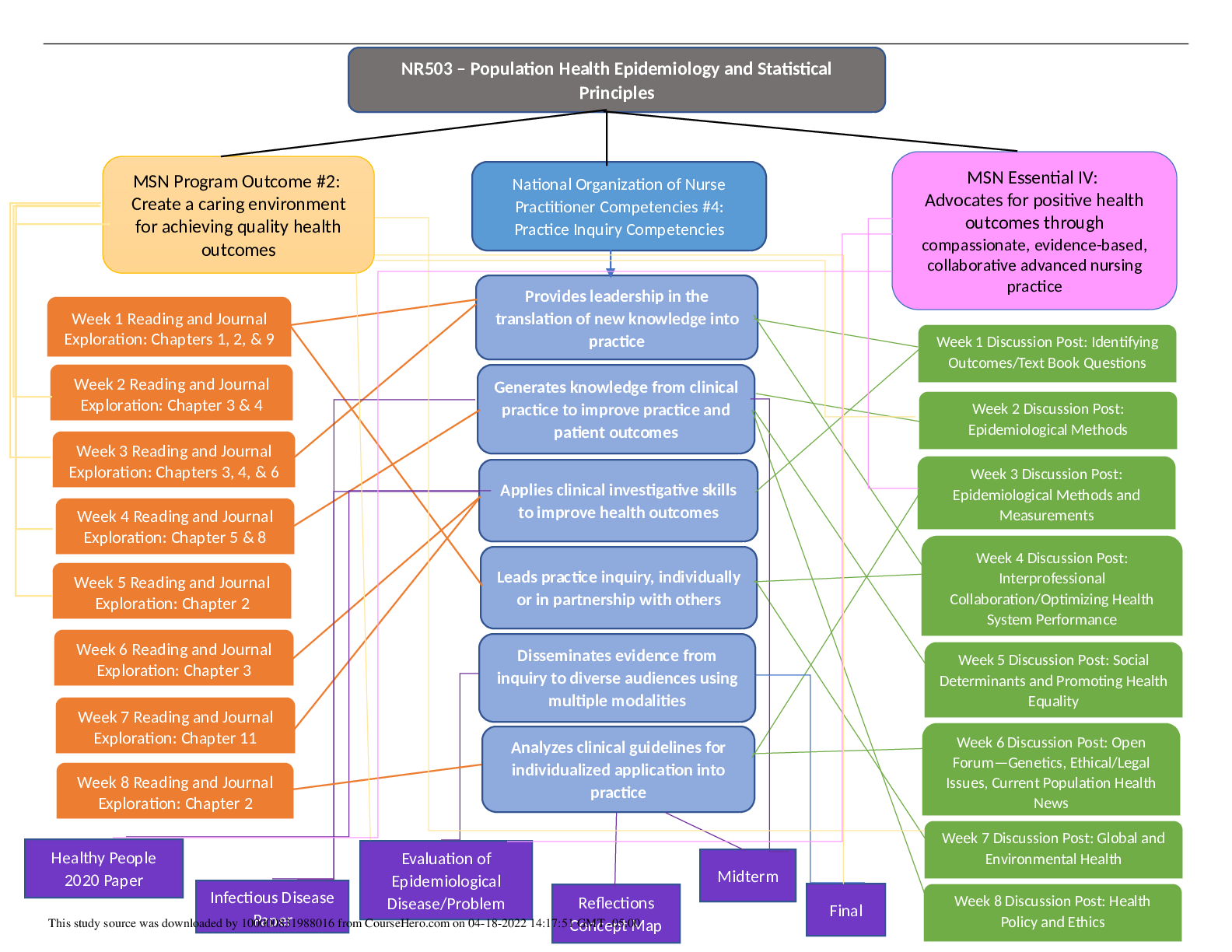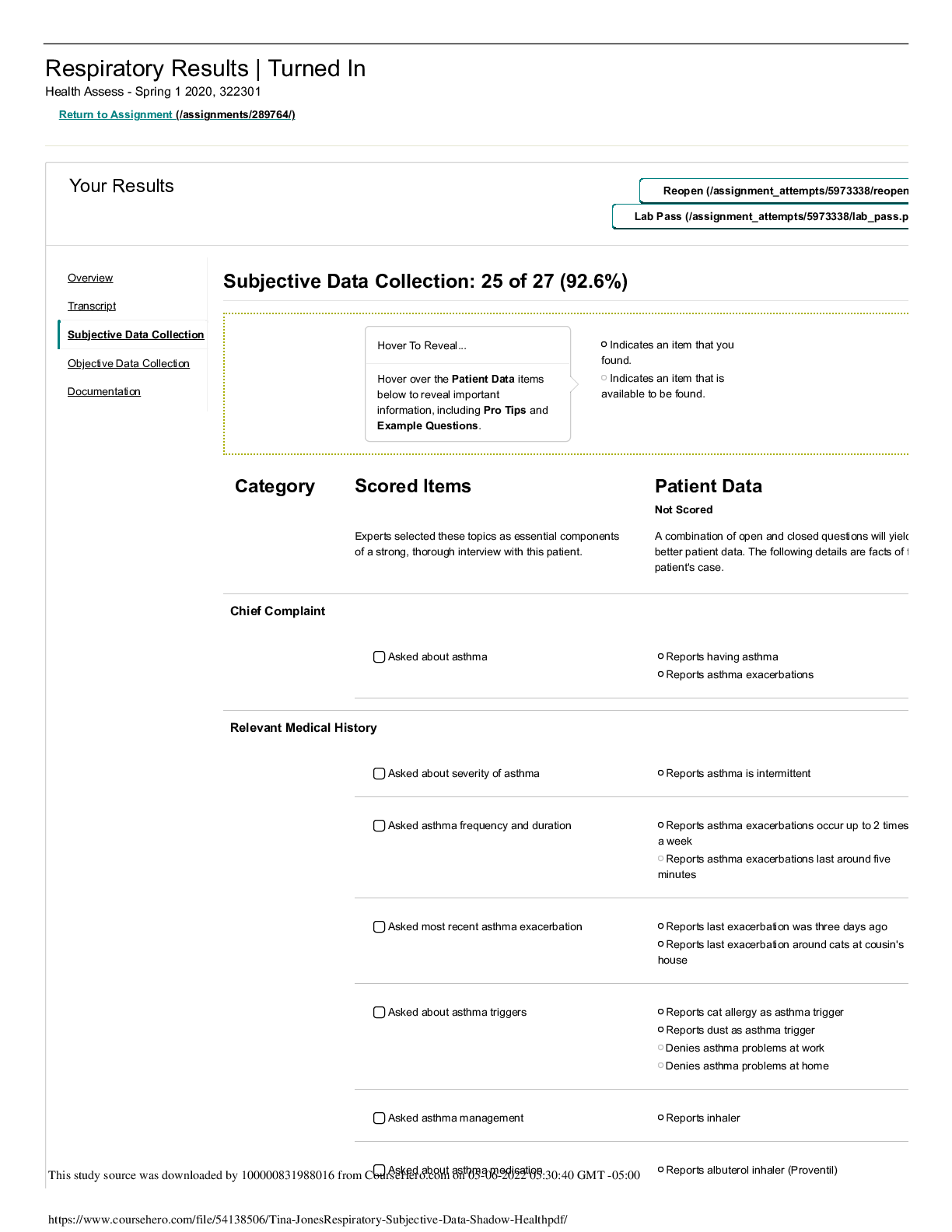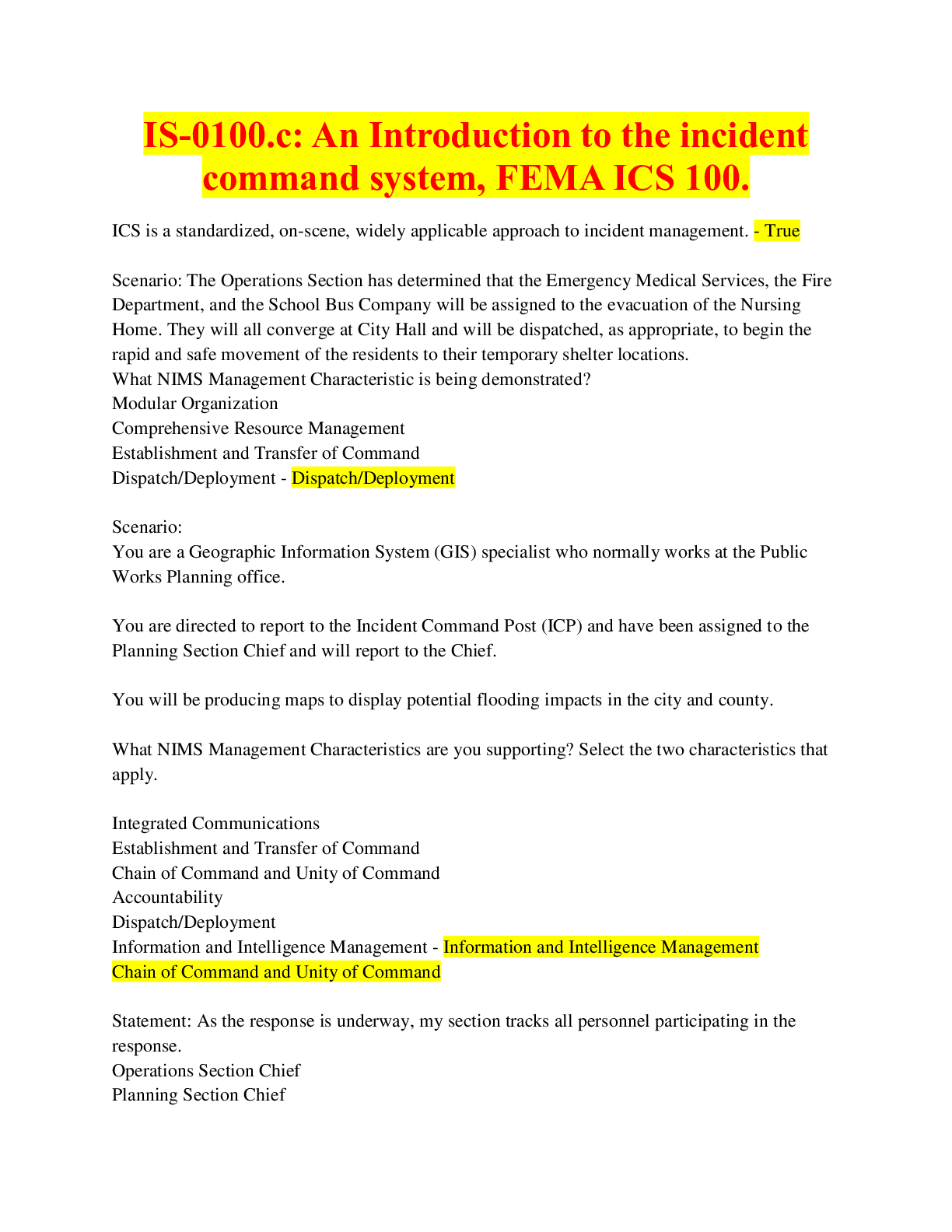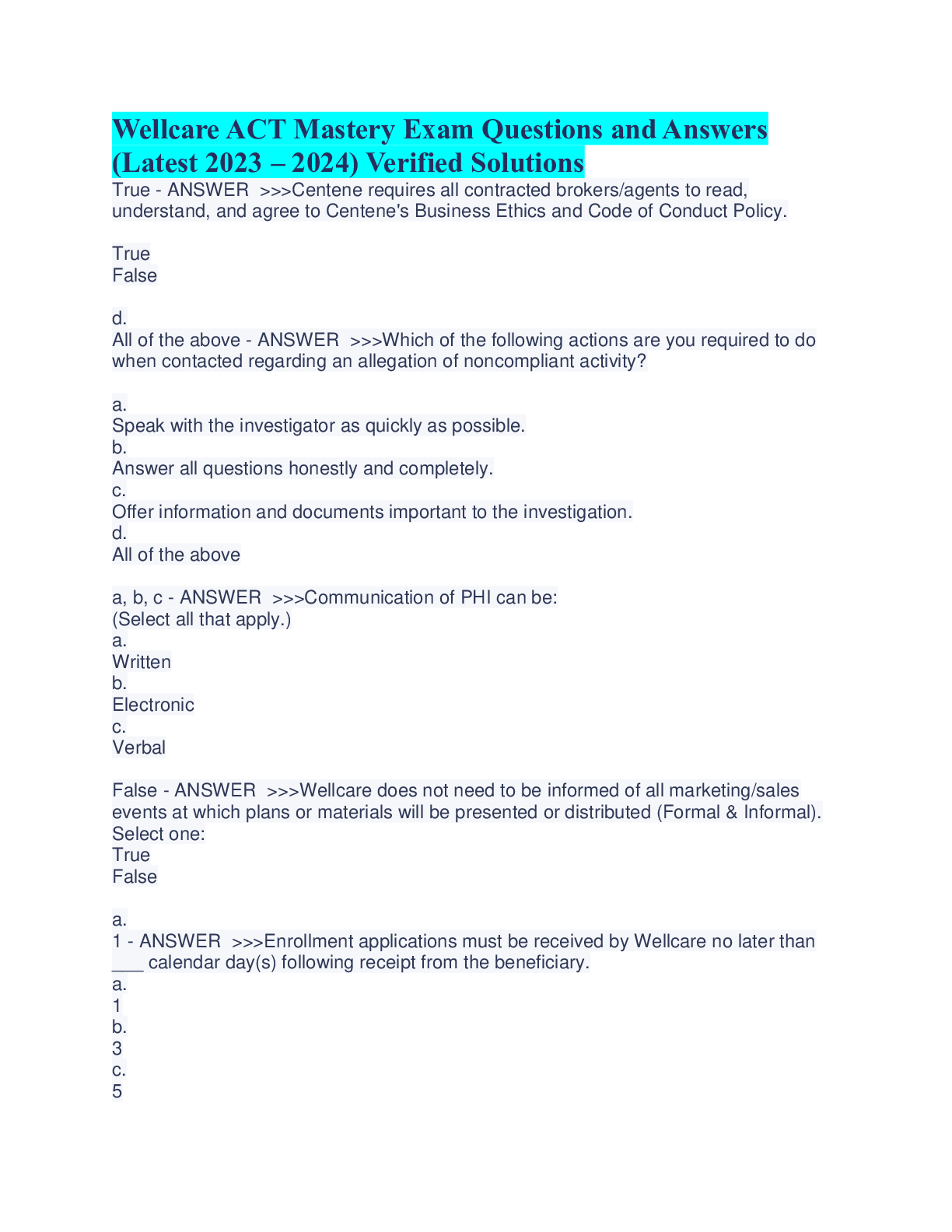2024 ATI MED SURG Content Mastery Exam Questions & Answers
Document Content and Description Below
2024 ATI MED SURG Content Mastery Exam Questions & Answers-A charge nurse is observing a newly licensed nurse provide care for a client who is receiving internal radiation therapy for the treatment of... cervical cancer. For which of the following actions by the newly licensed nurse should the charge nurse intervene? A. Leaving soiled linens in a container in the client's room i B. Instructing visitors to remain 2 m (6 feet) away from the client C. Borrowing a dosimeter film badge from another nurse before entering the client's room D. Removing an extra IV pole from the client's room to be used for another client - C A nurse should never borrow a dosimeter film badge from another staff member. Nurses who are caring for the client should each have a personal badge and wear it while in the client's room. The badge measures the radiation exposure that the nurse is receiving, and each film badge will indicate the nurse's cumulative radiation exposure. A client comes to the emergency department in severe respiratory distress following left-sided blunt chest trauma. The nurse notes absent breath sounds on the client's left side and a tracheal shift to the right. For which of the following procedures should the nurse prepare the client? A. Tracheostomy placement B. Thoracentesis. C. CT scan of the chest D. Chest tube insertion - D The client's manifestations indicate pneumothorax due to blunt chest trauma. The nurse should prepare for the provider to insert a chest tube and connect it to a water-seal drainage system. A home health nurse is performing an assessment on a client who is 1 week postoperative following a total knee replacement. Which of the following statements by the client indicates an understanding of the teaching? A. "I will discontinue the blood thinner my doctor prescribed once I am at home." B. "I will keep a pillow under my knee when I am in bed." C. "I plan to use a walker to help me get around." D. "I will discontinue using the CPM machine when I get home." - C The nurse should identify that the client will receive a prescription for a walker, cane, or crutches to promote ambulation following a total knee replacement. A nurse in a provider's office is assessing a client who has GERD. The nurse should expect the client to report which of the following manifestations? (Select all that apply.) A. Regurgitation B. Nausea C. Belching D. Heartburn E. Weight loss - ABCD A nurse in a provider's office is assessing a client's skin lesions. The nurse notes that the lesions are 0.5 cm (0.20 in) in size, elevated, and solid with distinct borders. The nurse should document these findings as which of the following skin lesions? A. Papules B. Macules C. Wheals D. Vesicles - A A papule is a small, solid, elevated lesion with distinct borders. It is usually smaller than 10 mm in diameter. Papules are common lesions of warts and elevated moles. A nurse in the PACU is assessing a newly admitted client and observes intercostal retractions and a high-pitched inspiratory sound. The nurse should identify these findings as manifestations of which of the following complications? A. Pulmonary edema B. Tension pneumothorax C. Flail chest D. Respiratory obstruction. - D. Intercostal retractions and a high-pitched inspiratory noise (i.e. stridor) are manifestations of an airway obstruction caused by laryngospasm and edema. The nurse should notify the rapid response team and plan to administer racemic epinephrine. A nurse is assessing a 66-year-old client during a routine physical examination. This is the client's first clinic visit, and she does not have her medical records. When the nurse asks if she has received the pneumococcal immunization, the client replies, "I am not sure, but it's been at least 5 years since I've had any immunizations. Which of the following responses should the nurse provide? A. "In case you had the immunization before, we can't give you another one." B. "You'll need a series of 3 injections." C. "This immunization is unsafe for people over the age of 65 years old." D. "Let's go ahead and give you this immunization." - D The Centers for Disease Control and Prevention recommend this immunization for people who are 65 years of age and older. If the client did receive this immunization more than 5 years ago, the nurse should administer another because the client is over 65. A nurse is assessing a client who has a complete intestinal obstruction. Which of the following findings should the nurse expect? A. Absence of bowel sounds in all 4 abdominal quadrants B. Passage of blood-tinged liquid stool C. Presence of flatus. D. Hyperactive bowel sounds above the obstruction - D The nurse should expect the client to have hyperactive bowel sounds above the obstruction because the intestinal peristalsis above the obstruction attempts to push the obstruction through the intestines. With a complete intestinal obstruction, there are no bowel sounds below the obstruction. A nurse is assessing a client who has a new diagnosis of acute angle-closure glaucoma. The nurse should anticipate the client to report which of the following manifestations? A. Multiple floaters B. Flashes of light in front of the eye C. Severe eye pain D. Double vision - C Severe eye pain is a manifestation of acute angle-closure glaucoma. Other manifestations can include report of halos around lights, blurred vision, headaches, brow pain, and nausea and vomiting. A nurse is assessing a client who has an exacerbation of herpes zoster. Which of the following manifestations of the client's skin should the nurse expect? A. Confluent, honey-colored, crusted lesions B. A large, tender nodule located on a hair follicle C. Unilateral, localized, nodular skin lesions D. A fluid-filled vesicular rash in the genital region - C Herpes zoster, or shingles, results from the reactivation of a dormant varicella virus. It is the acute, unilateral inflammation of the dorsal root ganglion. The infection typically develops in adults and produces localized vesicular lesions confined to a dermatome. It produces localized, nodular skin lesions. A nurse is assessing a client who has cholecystitis. Which of the following findings should the nurse expect? A. Blumberg's sign B. Ascites C.Gastrointestinal bleeding D. Kehr's sign - A The nurse should expect to find rebound tenderness (Blumberg's sign) in a client who has cholecystitis. This response can be an indication of peritoneal inflammation. A nurse is assessing a client who is receiving hemodialysis for the first time. Which of the following findings indicates that the client is developing dialysis disequilibrium syndrome (DDS)? A. Elevated BUN B. Bradycardia C. Headache D. Temperature 39.2°C (102.5°F) - C DDS is a CNS disorder that can develop in clients who are new to dialysis due to the rapid removal of solutes and changes in the blood pH. Clients beginning hemodialysis are at greatest risk, particularly if their BUN is above 175. DDS causes headaches, nausea, vomiting, a decreased level of consciousness, seizures, and restlessness. When the condition is severe, clients progress to confusion, seizures, coma, and death. A nurse is assessing a client with a closed head injury who has received mannitol for manifestations of increased intracranial pressure (ICP). Which of the following findings indicates that the medication is having a therapeutic effect? A. The client's serum osmolarity is 310 mOsm/L. B. The client's pupils are dilated. C. The client's heart rate is 56/min.. D. The client is restless. - A Mannitol is an osmotic diuretic used to reduce cerebral edema by drawing water out of the brain tissue. A serum osmolarity of 310 mOsm/Lis desired. A decrease in cerebral edema should result in a decrease in ICP. A nurse is assessing a female client who reports severe joint pain. The nurse should identify that which of the following factors places the client at risk for gout? A Perimenopause B. Migraine headaches C. Diuretic use D. Irritable bowel syndrome - C The client's use of diuretics is a risk factor for gout. Gout is a systemic disorder that affects the joints as a result of high uric acid levels in the blood. A nurse is assisting a provider with a comprehensive physical examination of a client. When the provider uses transillumination, the nurse should explain to the client that this technique helps evaluate which of the following structures? A. Lymph nodes B. Maxillary sinuses C. Intercostal spaces D. Salivary glands - B Transillumination is a procedure that allows the passage of light, often bright halogen light, through body tissues. Occluded sinuses prevent the passage of light rays through the sinus air sacs. Clear sinus air spaces allow transillumination. A nurse is caring for a client for whom the respiratory therapist has just removed the endotracheal tube. Which of the following actions should the nurse take first? A. Instruct the client to cough B. Administer oxygen via face mask C. Evaluate the client for stridor D. Keep the client in a semi-to high-Fowler's position - C The first action the nurse should take using the nursing process is to assess the client. After extubation, the nurse should continuously evaluate the client's respiratory status. Stridor is a high-pitched sound during inspiration that indicates laryngospasm or swelling around the glottis. Stridor reflects a narrowed airway and might require emergency reintubation. A nurse is caring for a client who had a below-the-knee amputation for gangrene of the right foot. The client reports sensations of burning and the toes of the absent right foot. Which of the following statements should the nurse make? A. "This type of pain usually decreases over time as the limb becomes less sensitive." B. "Try to look at the surgical wound as a reminder the limb is gone." C. "Use a cold compress intermittently to decrease these pain sensations." D. "Grief over the lost limb can sometimes cause denial that the limb is really gone." - A The nurse should recognize that the client is reporting phantom limb pain, a frequent complication following an amputation. The nurse should instruct the client that the sensation should decrease over time. The nurse should recognize the pain, provide treatment, and handle the limb gently to decrease the risk of triggering pain. A nurse is caring for a client who has abdominal pain and possible pancreatitis. Which of the following laboratory results should the nurse identify as an Indication of pancreatitis? A. Decreased white blood cell (WBC) count B. Increased albumin level C. Increased serum lipase level D. Decreased blood glucose level - C Due to the release of lipase into the pancreas and autodigestion, pancreatitis causes an increased serum lipase level. A nurse is caring for a client who has expressive aphasia following a stroke. The nurse should identify that the stroke affected which of the following lobes of the client's brain? A. Occipital B. Temporal C. Frontal D. Limbic - C The nurse should identify that the posterior portion of the frontal lobe is responsible for the verbal expression of thoughts A nurse is caring for a client who is 3 days postoperative following a below-the-knee amputation. Which of the following actions should the nurse take? A. Place the client on a soft mattress B. Rewrap the residual limb with a bandage 3 times per day C. Assist the client into a prone position for 20 min every 8 hr daily D. Turn the client every 4 hr while in bed - B The nurse should rewrap the client's residual limb with a pressure bandage 3 times daily. This keeps the bandage taught, which ensures the residual limb will shrink. Rewrapping the bandage also allows the nurse to check the skin for redness or skin breakdown. A nurse is caring for a client who is postoperative following a thoracic lobectomy. The client has 2 chest tubes in place: 1 in the lower portion of the thorax and the other higher on the chest wall. When a family member asks why the client has 2 chest tubes, which of the following responses should the nurse make? A. "Two tubes were necessary due to excessive bleeding from the area of the surgery." B. "The tubes drain blood from 2 different lung areas." C. "The lower tube will drain blood, and the higher tube will remove air." D. "The second tube will take over if blood clots block the first tube." - C The tube that is lower on the thorax will drain blood, and the tube that is higher on the thorax will allow for removal of air. A nurse is caring for a client who is postoperative following a urinary diversion to treat bladder cancer. Which of the following interventions should the nurse include in the plan of care? A. Empty the collection pouch when it is 2/3 full B. Expect urine outflow into pouch to begin 1 to 2 days after surgery C. Change the collection pouch in the early morning D. Place an aspirin in the collection pouch to control odor - C The nurse should plan to change the urinary collection pouch in the early morning when urine output is reduced. A nurse is caring for a client who is receiving peritoneal dialysis. The nurse notes that the client's dialysate output is less than the input and that his abdomen is distended. Which of the following actions should the nurse take? A. Insert an indwelling urinary catheter B. Administer pain medication to the client Rate the quality of this g C. Change the client's position D. Place the drainage bag above the client's abdomen - C This client is retaining the dialysate solution after the dwell time. The nurse should ensure that the clamp is open and the tubing is not kinked and should reposition the client to facilitate the drainage of the solution from the peritoneal cavity. A nurse is caring for a client who is scheduled to have his chest tube removed. Which of the following actions should the nurse take? A. Cover the insertion site with a hydrocolloid dressing after removal B. Provide pain medication immediately after removal C. Instruct the client to perform the Valsalva maneuver during removal D. Delegate removal of the chest tube to a licensed practical nurse (LPN) - C The nurse should instruct the client to perform the Valsalva maneuver during removal to maintain the appropriate amount of negative pressure in the chest in order to prevent air entry into the pleural space. [Show More]
Last updated: 3 months ago
Preview 1 out of 16 pages
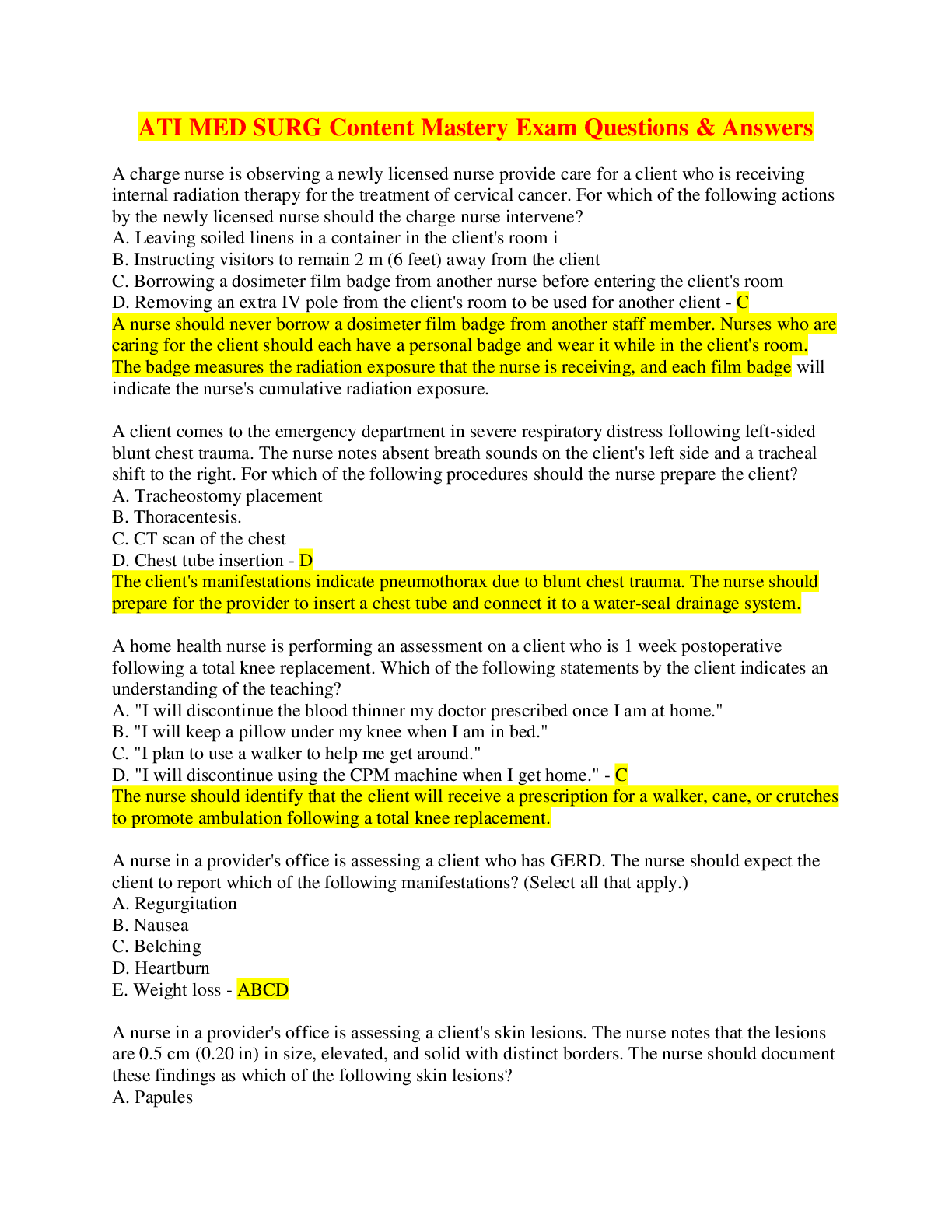
Buy this document to get the full access instantly
Instant Download Access after purchase
Add to cartInstant download
We Accept:

Reviews( 0 )
$13.50
Document information
Connected school, study & course
About the document
Uploaded On
Mar 17, 2024
Number of pages
16
Written in
Additional information
This document has been written for:
Uploaded
Mar 17, 2024
Downloads
0
Views
38






